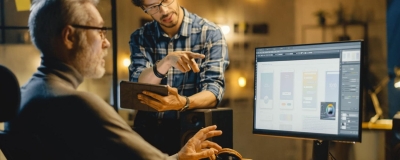The Evolution of E-commerce Web Design: Maximising Sales and Conversions
In the ever-changing landscape of online business, e-commerce web design is critical in deciding an online store’s success or failure. Staying ahead of the curve in web design is critical for maximising sales and conversions as technology changes and customer behaviors change. This blog will look at the evolution of e-commerce web design, delving into major trends, best practices, and techniques that businesses can employ to create visually beautiful and user-friendly online storefronts.
1. The Early Days of E-commerce Web Design
To understand the growth of e-commerce site design, one must first consider its humble beginnings. Websites in the early days of online purchasing were frequently rudimentary and lacked the aesthetic appeal associated with modern e-commerce platforms. User experience was hampered by cluttered design, slow-loading pages, and limited usefulness.
Designers began to explore with more visually appealing layouts as technology and internet speeds improved. However, the emphasis remained on functionality rather than beauty. The major issues were basic product listings and a simple checkout process.
2. The Rise of User-Centric Design
The rise of user-centric design concepts marked a watershed moment in e-commerce web design. Designers began to prioritise the customer experience, realising that a smooth and delightful purchasing trip had a direct impact on conversion rates. User-friendly interfaces, intuitive navigation, and responsive design have all become essential components of efficient e-commerce web design.
As cellphones became more common, mobile responsiveness became more important. To accommodate the expanding number of mobile buyers, e-commerce websites are required to adapt to different screen sizes and resolutions. This transition was a watershed moment in the growth of e-commerce web design, recognising the various ways people accessed online retailers.
3. Minimalism and Simplicity
Minimalism and simplicity gained importance in the e-commerce sector as web design trends matured. Layouts that were clean and uncomplicated became the norm, focusing on key features and reducing visual noise. This design strategy sought to increase customer emphasis on products while also streamlining the purchasing process.
Minimalistic designs not only improved aesthetics, but also contributed to speedier loading times, which is crucial in keeping impatient online buyers. The emphasis on simplicity extended to streamlined checkout processes, which reduced friction and increased the likelihood of successful transactions.
4. Visual Storytelling and Branding
Establishing a strong brand identity has become critical in the competitive e-commerce business. Visual storytelling has evolved as an effective strategy for connecting with clients on a more personal level. To create a story and inspire emotions, e-commerce websites began to use high-quality images, appealing product photography, and engaging videos.
Effective web design branding extends beyond logos and colour palettes. It entails generating a consistent and memorable experience for the intended audience. This movement signified a transition from transaction-focused design to relationship-focused design, where the goal was to build a lasting connection with the consumer rather than just sell a product.
5. Personalization and AI Integration
The introduction of artificial intelligence (AI) ushered in a new era in e-commerce web design. Personalisation has emerged as a critical technique for improving the user experience and increasing conversions. To provide personalised recommendations, product suggestions, and targeted promotions, AI systems analysed user behaviour, preferences, and purchase history.
Dynamic content, adaptive interfaces, and personalised purchasing journeys have all become standard features of sophisticated e-commerce site design. The ability to cater to individual preferences enhanced not only customer happiness but also sales and client loyalty dramatically.
6. Mobile-First Design
With the ongoing rise in mobile usage, designing for mobile-first has become critical for e-commerce success. As mobile devices superseded desktop computers as the primary means of accessing online content, designers began to prioritise mobile responsiveness and optimise the user experience for smaller screens.
Mobile-first design includes not only flexible layouts but also touch interactions, simpler navigation, and condensed but impactful content. Google’s mobile-first indexing emphasised the importance of mobile-friendly websites in search engine rankings, encouraging e-commerce companies to invest in responsive and mobile-optimised designs.
7. Social Commerce Integration
As social media platforms grew in popularity, including social commerce into e-commerce web design became a game changer. Social sharing buttons, user-generated content, and seamless integration with popular social platforms began to appear on e-commerce websites.
Social commerce enabled people to discover products via social media, share their purchases, and interact more interactively with brands. This integration not only increased the reach of e-commerce stores, but also enabled a more social and community-focused buying experience.
8. Augmented Reality (AR) and Virtual Try-Ons
In order to provide a more immersive online buying experience, e-commerce web design began to include augmented reality (AR) technologies. Virtual try-ons have become a common feature in industries such as fashion and beauty, allowing customers to visualise products in real-world surroundings before purchasing.
The incorporation of augmented reality not only improved the user experience but also addressed the inherent uncertainty of online purchase. Customers might now make more informed purchases by electronically trying on apparel, accessories, or even furniture, minimising returns and enhancing overall happiness.
9. Voice Commerce and Conversational Interfaces
Voice-activated virtual assistants and smart speakers heralded a new era of e-commerce interactions. To cater to customers who preferred voice commands over traditional typing, e-commerce web design began implementing conversational interfaces and voice commerce capabilities.
Chatbots and AI-powered conversational interfaces provided personalised support, answered questions, and even directed users through the shopping process. This design progression intended to make online purchasing more accessible and convenient, especially for customers who were multitasking or on the go.
10. Responsive Customer Support and Chatbots
Outstanding customer service has long been a distinction for successful e-commerce enterprises. In the ever-changing landscape of web design, the incorporation of adaptable customer assistance and chatbots has become critical. An improved customer experience was made possible via real-time help, proactive issue resolution, and automated responses.
Chatbots powered by AI assisted with routine queries, product information, and even the checkout process. Customer service was seamlessly integrated into the website layout, removing communication obstacles and encouraging confidence and loyalty among online shoppers.
11. The Future of E-commerce Web Design
As we look ahead, emerging technology and changing consumer expectations continue to affect the future of e-commerce web design. Several trends will almost certainly define the next stage of e-commerce evolution:
-
- Augmented Reality (AR) and Virtual Reality (VR) Integration: The application of AR and VR technology is likely to advance, providing immersive shopping experiences that go beyond virtual try-ons. Virtual shopping environments and interactive product presentations may become commonplace.
-
- Blockchain for Trust and Transparency: Blockchain technology could be implemented into e-commerce systems to improve transaction trust and transparency. Secure payment mechanisms, transparent supply chain tracking, and the removal of counterfeit products might all be part of this.
- Eco-Friendly and Sustainable Design: E-commerce site design may priorities eco-friendly and sustainable techniques as public awareness of environmental issues grows. This could involve using simple designs to save electricity and displaying ecologically friendly products.
- Integration of 5G Technology: The introduction of 5G technology is expected to transform internet speeds and connectivity. 5G may be used by e-commerce websites to provide even faster loading times, high-quality images, and seamless customer experiences.
- Emphasis on Accessibility and Inclusivity: E-commerce site design will most likely priorities accessibility for users with varying needs. This involves designing for disabled people, offering numerous language options, and ensuring that the online buying experience is accessible to everybody.












